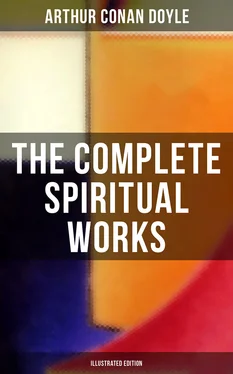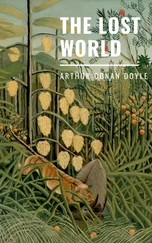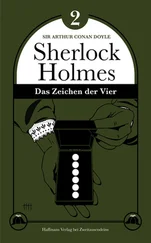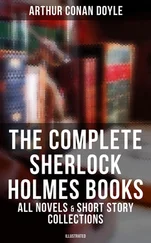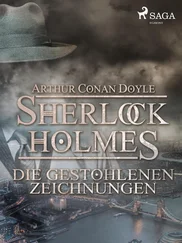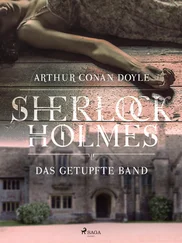We are accustomed to the idea of amphibious creatures who may dwell unseen and unknown in the depths of the waters, and then some day be spied sunning themselves upon a sandbank, whence they slip into the unseen once more. If such appearances were rare, and if it should so happen that some saw them more clearly than others, then a very pretty controversy would arise, for the sceptics would say, with — every show of reason, “Our experience is that only land creatures live on the land, and we utterly refuse to believe in things which slip in and out of the water; if you will demonstrate them to us we — will begin to consider the question.” Faced by so reasonable an opposition, the others could only mutter that they had seen them with their own eyes, but that they could not command their movements. The sceptics would hold the field.
Something of the sort may exist in our psychic arrangements. One can well imagine that there is a dividing line, like the water edge, this line dependiing upon what we vaguely call a higher rate of vibrations. Taking the vibration theory as a working hypothesis, one could conceive that by raising or lowering the rate the creatures could move from one side to the other of this line of material visibility, as the tortoise moves from the water to the land, returning for refuge to invisibility as the reptile scuttles back to the surf. This, of course, is supposition, but intelligent supposition based on the available evidence is the pioneer of science, and it may be that the actual solution will be found in this direction. I am alluding now, not to spirit return, where seventy years of close observation has given us some sort of certain and definite laws, but rather to those fairy and phantom phenomena which have been endorsed by so many ages, and still even in these material days seem to break into some lives in the most unexpected fashion.
Victorian science would have left the world hard and clean and bare, like a landscape in the moon; but this science is in truth but a little light in the darkness, and outside that limited circle of definite knowledge we see the loom and shadow of gigantic and fantastic possibilities around us, throwing themselves continually across our consciousness in such ways that it is difficult to ignore them.
There is much curious evidence of varying value concerning these borderland forms, which come or go either in fact or imagination — the latter most frequently, no doubt. And yet there remains a residue which, by all human standards, should point to occasional fact. Lest I should be too diffuse, I limit myself in this essay to the fairies, and passing all the age-long tradition, which is so universal and consistent, come down to some modern instances which make one feel that this world is very much more complex than we had imagined, and that there may be upon its surface some very strange neighbours who will open up inconceivable lines of science for our posterity, especially if it should be made easier for them, by sympathy or other help, to emerge from the deep and manifest upon the margin.
Taking a large number of cases which lie before me, there are two points which are common to nearly all of them. One is that children claim to see these creatures far more frequently than adults. This may possibly come from greater sensitiveness of apprehension, or it may depend upon these little entities having less fear of molestation from the children. The other is, that more cases are recorded in which they have been seen in the still, shimmering hours of a very hot day than at any other time. “The action of the sun upon the brain,” says the sceptic. Possibly — and also possibly not. If it were a question of raising the slower vibrations of our surroundings one could imagine that still, silent heat would be the very condition which might favour such a change. What is the mirage of the desert? What is that scene of hills and lakes which a whole caravan can see while it faces in a direction where for a thousand miles of desert there is neither hill nor lake, nor any cloud or moisture to produce refraction? I can ask the question, but I do not venture to give an answer. It is clearly a phenomenon which is not to be confused with the erect or often inverted image which is seen in a land of clouds and of moisture.
If the confidence of children can be gained and they are led to speak freely, it is surprising how many claim to have seen fairies. My younger family consists of two little boys and one small girl, very truthful children, each of whom tells with detail the exact circumstances and appearance of the creature. To each it happened only once, and in each case it was a single little figure, twice in the garden, once in the nursery. Inquiry among friends shows that many children have had the same experience, but they close up at once when met by ridicule and incredulity. Sometimes the shapes are unlike those which they would have gathered from picture-books. “Fairies are like nuts and moss,” says one child in Lady Glenconner’s charming study of family life. My own children differ in the height of the creatures, which may well vary, but in their dress they are certainly not unlike the conventional idea, which, after all, may also be the true one.
There are many people who have a recollection of these experiences of their youth, and try afterwards to explain them away on material grounds which do not seem adequate or reasonable. Thus in his excellent book on folk-lore, the Rev. S. Baring-Gould gives us a personal experience which illustrates several of the points already mentioned. “In the year 1838,” he says, “when I was a small boy of four years old, we were driving to Montpelier on a hot summer day over the long straight road that traverses a pebble-and-rubble-strewn plain, on which grows nothing save a few aromatic herbs. I was sitting on the box with my father when, to my great surprise, I saw legions of dwarfs of about two feet high running along beside the horses; some sat laughing on the pole, some were scrambling up the harness to get on the backs of the horses. I remarked to my father what I saw, when he abruptly stopped the carriage and put me inside beside my mother, where, the conveyance being closed, I was out of the sun. The effect was that, little by little, the host of imps diminished in number till they disappeared altogether.”
Here, certainly, the advocates of sunstroke have a strong, though by no means a final, case. Mr. Baring-Gould’s next illustration is a sounder one.
“When my wife was a girl of fifteen,” he says, “she was walking down a lane in Yorkshire, between green hedges, when she saw seated in one of the privet hedges a little green man, perfectly well made, who looked at her with his beady black eyes. He was about a foot or fifteen inches high. She was so frightened that she ran home. She remembers that it was a summer day.”
A girl of fifteen is old enough to be a good witness, and her flight and the clear detail of her memory point to a real experience. Again we have the suggestion of a hot day.
Baring-Gould has yet a third case. “One day a son of mine,” he says, “was sent into the garden to pick pea-pods for the cook to shell for dinner. Presently he rushed into the house as white as chalk to say that while he was thus engaged, and standing between the rows of peas, he saw a little man wearing a red cap, a green jacket, and brown knee-breeches, whose face was old and wan, and who had a grey beard and eyes as black and hard as sloes. He stared so intently at the boy that the latter took to his heels.”
Here, again, the pea-pods show that it was summer, and probably in the heat of the day. Once again the detail is very exact and corresponds closely, as I shall presently show, to some independent accounts. Mr. Baring-Gould is inclined to put all these down to the heat conjuring up the familiar pictures of fairy books, but some further evidence may cause the reader to doubt this explanation.
Читать дальше
